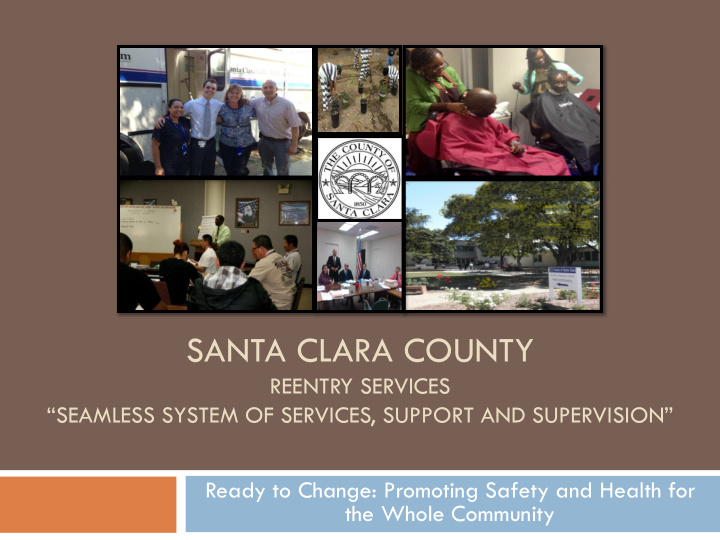



SANTA CLARA COUNTY REENTRY SERVICES “SEAMLESS SYSTEM OF SERVICES, SUPPORT AND SUPERVISION” Ready to Change: Promoting Safety and Health for the Whole Community
Why are we here? 2 Celebrate our achievements Share our challenges and goals Listen to client testimonials “ Collective intelligence Inform stakeholders of our trumps individuals progress smarts to solve a shared problem.” Understand case planning from our experts Engage in frank conversations and exchange ideas
Summit Agenda 3 Welcome & Purpose Client’s Testimonials Reentry Efforts in Santa Clara County as seen by our Evaluator Frontline Perspective on Effective Case Planning Applying Case Planning with Client Vignettes Discuss Next Steps & Wrap Up
Vision & Mission 4 Vision Building safer communities and strengthen families through the successful reintegration and reentry of formerly incarcerated individuals back into Santa Clara County. Mission To reduce recidivism by using evidence-based practices towards implementing a seamless system of services, supports, and supervision.
Guiding Principles & Values 5 Reentry and reintegration begin while the individual is incarcerated. Evidence-based practices are utilized when developing programs and policies. Collaboration, coordination, information, and communication are critical to the success and sustainability of the Reentry Network. Formerly incarcerated individuals with a risk level of high to moderate are targeted through the use of validated assessment tools. Assessment and case management tools are utilized to provide continuous reentry planning, and are incorporated at the point of entry into the criminal justice systems and continue to be used throughout pre- and post-release. The strategic plan is designed to be gender-responsive, trauma- informed, and culturally competent.
2013 Achievements 6 Successfully executed the Adult Reentry Services RFP & Service Agreements Established the Office of Reentry Services Developed the Reentry Systems Mapping Process Enhanced communication between cross- functional teams Promoted evidence-based approaches as a guiding force towards developing Reentry Programs Board approved FY 2014 Budget that included $4 million for housing programs
2014 Goals 7 Identify system needs and structural changes in order to improve service delivery Measure the nature and impact of peer support and faith community engagement as essential components to an effective system of care. Rebrand MAP and create a new welcome center Complete the outcome measurement analysis of AB 109 individuals Establish a quarterly reentry data dashboard Develop ongoing Professional Development Training with Partner Agencies Cultivate the continued growth of a Reentry Team Concept
Current Challenges 8 Recidivism has been established and now requires consensus on reporting. The individual client services and outcomes are still unknown at this time. How to address the most critical clients with highest needs? How to collaborate with the Cities’ AB 109 Task Force and sharing of information? How to maintain current level of service and fund critical residential treatment with potential lower revenue projections?
What do we need to know? 9 What are the effects of realignment on crime, recidivism, and local criminal justice systems? Do the services we refer people to decrease their recidivism? Is flash incarceration leading to behavioral change? Do offenders given split sentences do better, worse, or the same as offenders given straight sentences? Are the substance abuse and mental health programs effective? Are there promising evidence based practices being used elsewhere that could benefit our county?
How the County defines Recidivism 10 The Community Corrections Partnership and the Public Safety & Justice Committee approved the following: The occurrence of convictions or sustained petitions of new law violations (both misdemeanors and felonies) within five years of existing custody or entering supervision, whichever is later. Additional contextual measures include: Arrests, demographic factors such as race/ethnicity, risk level, offense level, offense type, technical violations, chronic violators, and sentencing or dispositional outcomes. Recidivism can be tracked by offense type: Misdemeanor; General Felony; Serious Felony; and Violent Felony
Our approach to calculate Recidivism rate 11 Study Population: PRCS and 1170h(MS) individuals entering supervision & 1170h leaving County Jail between October 1, 2011 and December 31, 2011. Each client has a 12-month and 24-month timeline to re-offend Timeline: As reported to the Board on August 8, 2013 we will develop a recidivism tracking report for AB 109 clients and work with RDA to include in the Process Evaluation and Performance Report due in April 2014.
Next Steps 12 Support process and outcome evaluation and analysis of service and justice-system data to assess relationship between services and recidivism. PSJC – April 2014 Share lessons learned on effective case management and develop specialized case conferencing. Prioritize enrollment of inmates in the jail to take advantage of the Affordable Care Act. Examine the outcomes and efficacy of the assessment and referral process at the Reentry Resource Center. Consider a Spring/Fall Summit with community based organizations serving our reentry population.
Recommend
More recommend